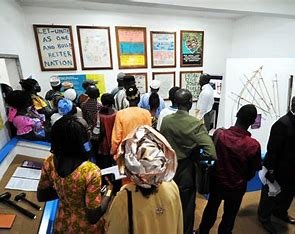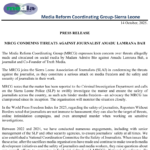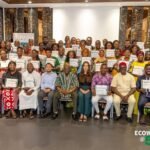By Alfred Koroma (MRCG/ATJLF Fellow 2025)
“Over 50,000 people died in the war,” recalls Patrick Fatoma, Outreach Focal Person for the Residual Special Court of Sierra Leone, as he explained the divisions of the Peace Museum and its significance in remembering the war.
On a wall outside the museum’s main building, 2,500 names stand as silent sentinels, each inscribed with details of district, gender, age, and the exact month and year when their respective lives were lost. Fatoma calls them the war dead. They were recorded by the Truth and Reconciliation Commission (TRC) as a tribute to those lost in the chaos of the conflict.
Established in 2013, the Peace Museum stands as a solemn testament to Sierra Leone’s journey from war to reconciliation. It emerged as a legacy project of the Special Court for Sierra Leone (SCSL), which prosecuted key perpetrators of the war, including former Liberian President Charles Taylor. Located in a spacious compound, once the site of the historic Special Court, the museum now preserves the memory of both the atrocities and the resilience of the eleven-year conflict that began in 1991. Every exhibit tells a story: from the “magical” uniforms and charms of the Civil Defense Forces, locally known as ‘Kamajors,’ to harrowing photographs of mass graves, and documents chronicling the Special Court trials. Each piece reveals a period defined by trauma and the desperate struggle for justice.
According to the TRC’s findings in Volume Two, Chapter Two, the central cause of the war was “endemic greed, corruption, and nepotism that deprived the nation of its dignity and reduced most people to a state of poverty.” The report further elaborates that successive political elites plundered the nation’s assets, including its mineral riches, at the expense of the national good. Government accountability was non-existent, and institutions meant to uphold human rights were thoroughly co-opted by the executive.
Official estimates as published by Amnesty International put the number of deaths, including both combatants and non-combatants, at 10,000. However, the real number of casualties is believed to be several thousand more.
“We have over 50,000 people killed during the war. It’s hard to say exactly how many died because many died either in forests, or died while running away from the conflict,” Fatoma said.
He explained that the Museum is divided into seven sections. The first is the main hall, where pictures of the TRC Commissioners, who investigated the causes of the war, are displayed. The walls of the hall list the causes of the war as explained by the Commission. Photos of mass graves, images of interpreters, principals, judges, and registrars of the SCSL, along with visions shared by Sierra Leoneans, are all displayed.
The archive room contains public documents from the Special Court trial, along with three computer workstations where information about the court can be researched online. There is also a hallway exhibiting artifacts from the Civil Defense Forces, including magical clothing, caps, medals, medallions, and hand bands believed to have mystical powers.
At the end of the hallway, two other rooms exist: one dedicated to peacekeepers, containing information about the role of Nigerian and Mongolian peacekeepers in protecting the court during the trial, and the other, a crime scene room. The crime scene room portrays atrocities such as amputations, the disembowelment of pregnant women, and the rape of girls, women, and nursing mothers, primarily committed by the Revolutionary United Front and the Armed Forces Revolutionary Council fighters.
The fifth room houses extra materials that should have been displayed in the hallway but could not fit due to space constraints, Fatoma explained.
At the back of the Museum lies the memorial garden, one of its most striking features. This quiet space honors victims and promotes reflection. It displays images depicting the suffering endured during the war and ends with representations of transitional justice mechanisms — the TRC and Special Court. The 2,500 names of the war dead are inscribed here, alongside representations of gravestones for each of the country’s 16 districts.
Above the exit door of the memorial garden, a question prompts visitors: “Now that you have seen everything in the Peace Museum and the Memorial Garden, what can you, as an individual, do to ensure that Sierra Leone has peace forever?”
This encourages visitors to reflect on the lessons learned and engage in dialogues that promote peace.
As Fatoma explains “many of the responses we have received from visitors, especially schoolchildren, emphasize respect for human rights, the rule of law, and active participation in peace-promoting activities. Many express their commitment to rejecting discussions about starting another war.”
Another entrance to the Peace Museum leads to the Law School. A bridge between them, called the Peace Bridge, stands near a memorial that reads, “The war don don” (The war is over), a statement made by President Ahmed Tejan Kabbah.
The war was marked by unimaginable brutality, including widespread sexual violence, the recruitment of child soldiers, and the use of amputation as a terror tactic. Fueled by power struggles over diamond revenues, social inequality, and youth disenfranchisement, the conflict left deep scars on the nation’s social fabric.
Peace and Good Governance
After the war ended in 2002, many Sierra Leoneans hoped for a better future. Artwork by citizens, displayed in the museum, envisions a future where Sierra Leone’s resources benefit all its people rather than fueling division.
And since the war ended, the country has undergone six democratic elections, and successive governments have made significant strides in maintaining peace. But, the root causes of the conflict, such as corruption, inequality, poor governance, and youth unemployment, as identified in the TRC report, remain unresolved and many Sierra Leoneans are not happy with the way the country is being run.
“After years of war that devastated our people and economy, we had hoped for a new beginning built on accountability, justice, and progress,” said Mohamed Kamara, a Peace and Conflict graduate. “Instead, we see the same corrupt practices that fueled the war: leaders enriching themselves while ordinary citizens struggle to afford basic necessities.”
“There are no better jobs for the youth, and everything has become so expensive,” he added.
However, Fatoma argues that Sierra Leone is significantly better off now than during both the war and prewar periods. “In the 1960s and 1970s, there was no good governance. From the 1970s to the early 1990s, it was a one-party system. But after the war, we have had peaceful elections. The TRC also recommended inclusion, which we now see in institutions like the Human Rights Commission, the Ombudsman Office, and the Independent Commission for Peace and National Cohesion,” he said.
By promoting peace, preserving the truth, and honoring victims, the Peace Museum remains a vital reminder of the cost of conflict and the value of peace. As Sierra Leone continues its journey of peace and development, the museum stands as a powerful symbol of resilience and a call to action for future generations.
As Vice President Mohamed Juldeh Jalloh notes during a visit to the Museum in October last year: “The museum is a powerful symbol of hope, and it is essential that its message endures across generations.” The cost of conflict is too high to forget, and the need for enduring peace and good governance has never been more urgent.
This story is brought to you with support from the Africa Transitional Justice Legacy Fund (ATJLF) through the Media Reform Coordinating Group (MRCG) under the project “Engaging Media and Communities to Change the Narrative on Transitional Justice Issues in Sierra Leone.”










Leave a Reply